Scleroderma verrucosum ( Bull.: Pers.) Pers. - Scaly Earthball
Phylum: Basidiomycota - Class: Agaricomycetes - Order: Boletales - Family: Sclerodermataceae
Distribution - Taxonomic History - Etymology - Identification - Toxicity - Reference Sources
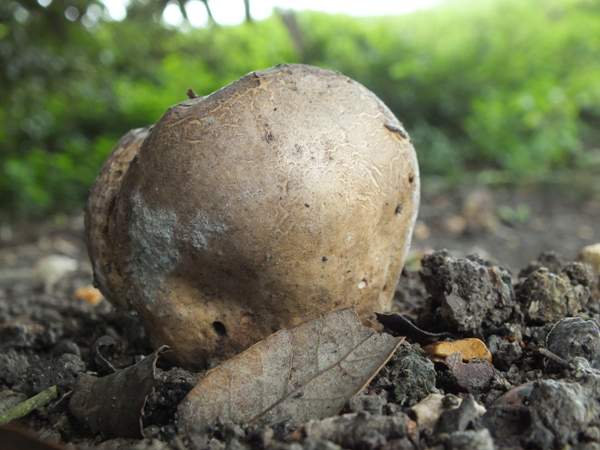
Scleroderma verrucosum, the Scaly Earthball, is remarkably similar in appearance to a baked potato. This earthball tends to be most common in sandy or nutrient-rich dryish soils, but it also appears in grassland and woodland habitats.
The long stem-like structure and large size are features that help distinguish the Scaly Earthball from other members of the genus Scleroderma; otherwise microscopic examination of the spores of a mature specimen is necessary.
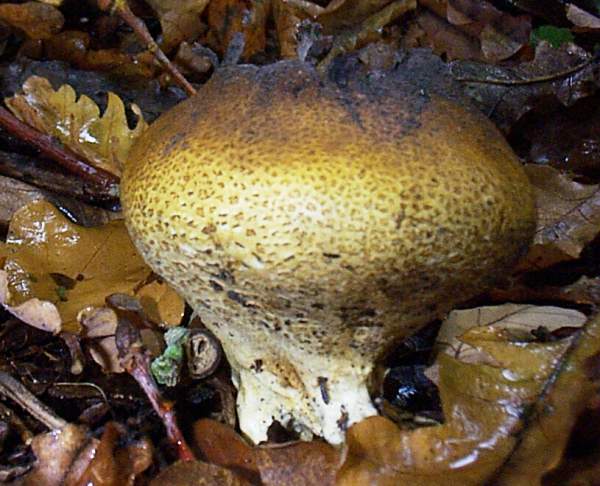
Distribution
The Scaly Earthball Scleroderma verrucosum is widespread and common throughout of Britain and Ireland. These poisonous fungi are found also throughout mainland Europe and in North America.
Taxonomic history
This fungus was first described in scientific literature in 1780 by Jean Baptiste Francois (Pierre) Bulliard, who gave it the binomial scientific name Lycoperdon verrucosum, in effect categorising it as a puffball.
It was Christian Hendrik Persoon who, in his Synopsis Methodica Fungorum published in 1801 (a date which marks the starting point for taxonomy of gasteromycete fungi) separated earthballs (Scleroderma spp.) from puffballs (Lycoperdon spp.), giving the Scaly Earthball what is now its generally-accepted scientific name Scleroderma verrucosum.
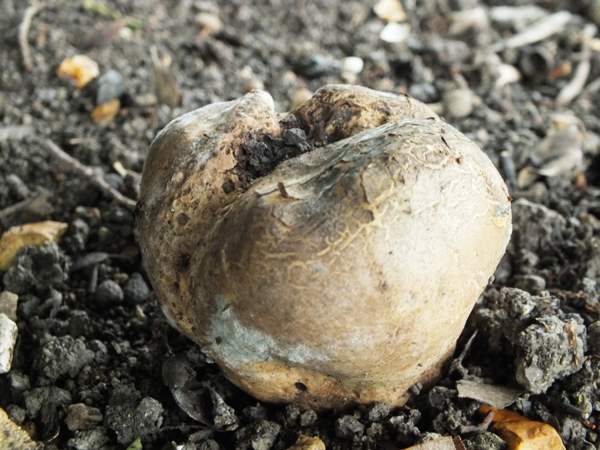
Synonyms of Scleroderma verrucosum include Lycoperdon verrucosum Bull., and Scleroderma maculatum (Peck) Lloyd.
The gasteromycetes are not a group of close relatives but simply a collection of fungi sharing the characteristic of producing spores within a sealed spherical, oval or pear-shaped casing. It turns out that Scleroderma fungi such as the Common Earthball are in fact close relatives of the boletes, and in particular boletes of the genus Gyroporus.
Etymology
The generic name Scleroderma comes from the Greek words scler- meaning hard, and -derma meaning skin. Earthballs certainly do have hard (and thick) skins. The specific epithet verrucosum comes from Latin and refers to the scaly-warty (verruca-like) patches on the peridium of these large earthballs.
Despite its common name the old Scaly Earthball is usually a lot less scaly than the Common earthball Scleroderma citrinum. The surface of the Scaly Earthball shown above is mainly smooth, having lost its spotty appearance. This is not an uncommon occurrence; however, it does make identification from macroscopic characters alone unreliable.
Type 'scleroderma' into a search engine and instead of learning about earthball fungi you will be directed to pages about a very unpleasant chronic systemic autoimmune disease that primarily affects the skin; fortunately it cannot be contracted by touching Scleroderma earthball fungi... as far as I know!
Toxicity
There are conflicting reports as to whether Scleroderma verrucosum is seriously poisonous; however, even when young and whitish throughout it is generally considered as at best inedible and suspect. Some people react to it very badly, and at worst it may even be seriously poisonous. Do not eat any of the earthballs.
Identification guide
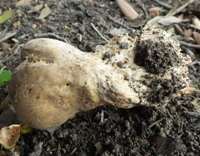 |
FruitbodyTypically 3 to 8cm across and 3 to 6cm tall, the rounded fruitbody is attached to a longitudinally grooved pseudostype (a stem-like structure of infertile material). From the base white mycelial cords emanate. The peridium (outer skin) of the Scaly Earthball is 0.5-1mm thick, reddish brown becoming more ochraceous as it ages; it is covered by small isolated angular scales. The peridium tends to shed its scales as the fruitbody matures. At maturity the apex of peridium ruptures leaving an irregular opening via which the wind and rain disperse the spores. |
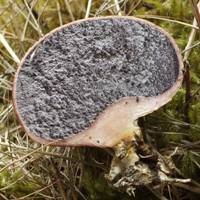 |
GlebaInside the earthball the spore mass is cream at first but soon turns purplish brown with fine white marbling before becoming brown and powdery throughout. |
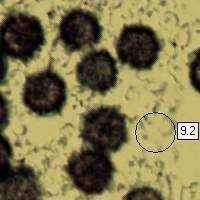 |
SporesSpherical, spiny, 9-11µm diameter (excluding spines) when fully mature; surface liberally covered with slim isolated spines (known as echinulae) 0.8 to 1.5µm tall without connecting ridges. Spore massDark brown. |
Odour/taste |
Not distinctive. |
Habitat |
Mycorrhizal; usually found growing on well drained, sandy soil or dry humus-rich soil under hardwood trees, notably oaks and Beech, but also found in grassy parkland, at woodland edges and on tree-lined roadside verges. There are reports of the Scaly Earthball occasionally growing from well-rotted wood, but I have not seen this. |
Season |
July to early December in Britain and Ireland. |
Similar species |
Earthballs are much less spongy than the various puffballs with which they are sometimes confused. Scleroderma citrinum does not have a significant pseudostipe. Lycoperdon perlatum, the common puffball, has pearly, pointed scales and is very spongy to the touch. It is club-like in shape and has a rudimentary infertile stipe. Lycoperdon mammiforme, another of the many puffball species, is white at first before its surface breaks up into large cream scales; it comprises a spongy fertile ball upon a spongy infertile stem. |
Reference Sources
Fascinated by Fungi, 2nd Edition, Pat O'Reilly 2016, reprinted by Coch-y-bonddu Books in 2022.
Pegler, D.N., Laessoe, T. & Spooner, B.M (1995). British Puffballs, Earthstars and Stinkhorns. Royal Botanic Gardens, Kew.
Dictionary of the Fungi; Paul M. Kirk, Paul F. Cannon, David W. Minter and J. A. Stalpers; CABI, 2008
Taxonomic history and synonym information on these pages is drawn from many sources but in particular from the British Mycological Society's GB Checklist of Fungi.
Fascinated by Fungi. Back by popular demand, Pat O'Reilly's best-selling 450-page hardback book is available now. The latest second edition was republished with a sparkling new cover design in September 2022 by Coch-y-Bonddu Books. Full details and copies are available from the publisher's online bookshop...

